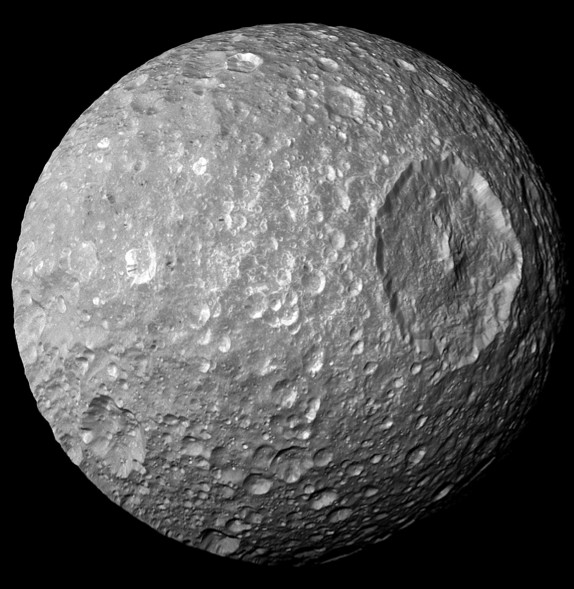An interesting recent space study found that one of Saturn's moons is behaving in a way scientists weren't expecting to see:
Mimas, one of Saturn's moons (nicknamed 'Death Star') has a telltale 'wobble', according to a new study.
"The data suggest that something is not right," Dr.Radwan Tajeddine, a Cornell University research associate in astronomy and the lead author of the article, said in a statement by NASA's Jet Propulsion Laboratory (JPL). "The amount of wobble we measured is double what was predicted."
The Cassani research associate went into more detail about what was "not right."
"After carefully examining Mimas, we found it librates - that is, it subtly wobbles - around the moon's polar axis," Tajeddine said in a Cornell statement. "In physical terms, the back-and-forth wobble should produce about 3 kilometers of surface displacement. Instead we observed an unexpected 6 kilometers of surface displacement."We suspect they're looking in the wrong direction - rather than looking into Mimas, they should be looking outwards at the changing solar system. Comet Siding-Spring is about to come 'once-in-a-million-years' close to Mars, several comets have impacted Jupiter in the last couple of decades, comet fragments are smacking Earth on a regular basis...
That led to the hypothesis of an underground body of water. "This is where we started thinking of more exotic interior models," Tajeddine told BBC News. "When we saw this wobbling, the first thing we thought of was an ocean."
If it possesses an ocean, which scientists estimate would be 15 to 18 miles underground, Mimas would join an exclusive club of "ocean worlds" that includes several moons of Jupiter and two other of Saturn moons, Enceladus and Titan, NASA said. But a global ocean would be surprising, according to Tajeddine, as the surface of Mimas does not display signs of geologic activity.
The research was funded by Université Pierre et Marie Curie, NASA's Cassini mission and the European Space Agency in collaboration with the Belgian Federal Science Policy Office. Cassini was sent to Saturn in 1997 to explore the planet and its many moons, which so far number 62 (53 with names).
Could it be that Mimas gained this new wobble by a large passing cometary body? Or is it symptomatic of the overall 'grounding' of the solar system, caused perhaps by the close approach of the system's Twin Sun?
See also:
Earth Changes and the Human-Cosmic Connection




Reader Comments
to our Newsletter